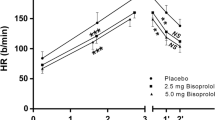Summary
A randomized, double-blind, placebo-controlled study was performed in 8 white and 8 black volunteers matched for sex, age and mass. The effect of 3 intravenous doses of a new, cardiose-lective beta-adrenergic blocker, bisoprolol, on the heart rate increase after standardized exercise was compared to that of 3 doses of propranolol.
As described previously for propranolol, black volunteers showed less response than whites to beta-blockade assessed in terms of the reduction in exercise-induced tachycardia. The effects of the two beta-blockers were similar and the apparent ethnic difference was seen with both drugs.
It has previously been shown that black volunteers have a higher intrinsic heart rate (i.e. heart rate after parasympathetic and beta-adrenergic blockade of the heart) than whites, but their resting heart rates are similar because of greater parasympathetic tone in blacks. When exercise-load was calculated as increase in heart rate above that after atropinization, no ethnic differences were seen.
It is suggested that in populations that are heterogenous in terms of the heart rate increase after atropine, work load should be standardized in terms of the increase in heart rate over the atropine heart rate rather than on absolute heart rate.
The apparent ethnic difference represents a flaw in methodology as applied to a heterogenous volunteer population.
Similar content being viewed by others
References
Humphries GS, Delvin DG (1968) Ineffectiveness of propranolol in hypertensive Jamaicans. Br Med J 2: 601–603
Voors AW, Bercuson GS, Schuler SE (1978) Racial differences in blood pressure control. Science 204: 1091–1094
Seedat YK (1980) Trial of atenolol and chlorthalidone for hypertension in black South Africans. Br Med J 281: 1241–1243
Abson CP, Levy LM, Eyherabide G (1981) Once-daily atenolol in hypertensive Zimbabwean blacks. S Afr Med J 60: 47–48
Venter CP, Joubert PH (1984) Ethnic differences in response to beta1-adrenoceptor blockade by propranolol. J Cardiovasc Pharmacol 6: 361–364
Venter CP, Joubert PH (1982) Ethnic differences in beta1-adrenoceptor sensitivity. S Afr Med J 62: 849–850
Venter CP, Joubert PH, Strydom WJ (1984) Ethnic differences in response to pharmacological denervation of the heart. IRCS Med Science 12: 963–964
Wellstein A, Palm D (1985) Penbutolol: Beta-adrenoceptor interaction and the time course of plasma concentrations explain its prolonged duration of action in man. Eur J Clin Pharmacol 29: 293–300
Wellstein A, Palm D, Pitschner HF et al. (1985) Receptor binding of propranolol is the missing link between plasma concentration kinetics and the effect-time course in man. Eur J Clin Pharmacol 29: 131–147
Arunlakshana O, Schild HO (1959) Some quantitative uses of drug antagonists. Br J Pharmacol 14: 48–58
Leopold W, Ungethun J, Pabst Z et al. (1986) Pharmacodynamic profile of bisoprolol a new beta1-selective adrenoceptor antagonist. Br J Clin Pharmacol 22: 356–359
Buehring KU, Garber A (1986) Determination of the new beta-blocker bisoprolol and of metoprolol, atenolol and propranolol in plasma and urine by high performance liquid chromatography. J Chromatogr 382: 215–224
Venter CP, Joubert PH, Strydom WJ (1985) Comparative pharmacokinetics of intravenous propranolol in black and white volunteers. J Carciovasc Pharmacol 7: 409–410
Coltart DJ, Shand DG (1970) Plasma propranolol levels in the quantitative assessment of beta-adrenergic blockade in man. Br Med J 3: 731–734
McDevitt DG (1977) The assessment of beta-adrenoceptor blocking drugs in man. Br J Clin Pharmacol 4: 413–425
Author information
Authors and Affiliations
Rights and permissions
About this article
Cite this article
Joubert, P.H., Venter, C.P. & Wellstein, A. Ethnic differences in response to beta-blockade: Fact or artefact? A study with bisoprolol and propranolol. Eur J Clin Pharmacol 34, 363–368 (1988). https://doi.org/10.1007/BF00542437
Received:
Accepted:
Issue Date:
DOI: https://doi.org/10.1007/BF00542437




